 Indians Archive
Indians Archive  Tribe Game Vault: 7/17/41. Joe DiMaggio’s Streak in ‘Jeopardy!’ in Cleveland
Tribe Game Vault: 7/17/41. Joe DiMaggio’s Streak in ‘Jeopardy!’ in Cleveland
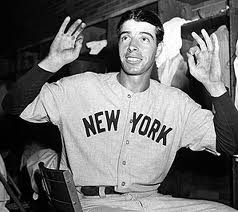 In 1941, New York Yankee center fielder Joe DiMaggio came to Cleveland and got Nancy Zerg’d.
In 1941, New York Yankee center fielder Joe DiMaggio came to Cleveland and got Nancy Zerg’d.
Through July 17th of that year, fans in American League cities attended Yankee games in the hope that their local nine would be the one to stop his streak. ‘The Yankee Clipper’ (the nickname was a reference to a new airliner of the era, one that was fast and had extra range) had hit successfully in 56 straight games. His Yankees had started this season slowly out of the gate. The poignant death of Lou Gehrig on June 2 was also hanging in the air. But by mid-July, the Yankees were in first place.
The United States was on the brink of another world war, although many refused to directly face that fact. Sports were an outlet that offered respite from the anxiety, and baseball was the king of sports in the U.S. (boxing was second).
The Streak, as it was known, started as quietly as most streaks do. DiMaggio, who had been in a hitting slump to start the season, began his historic run on May 15. By the time he passed George Sisler at 41 games, and then broke 'Wee' Willie Keeler’s record of hitting in 44 straight games, public fascination for the pride of Italian Americans had spread to the entire country.
Streaks are fascinating. Other kinds of records may be tough to attain, but the nature of most of them allow for periodic failure- oh well, we can try for it again next 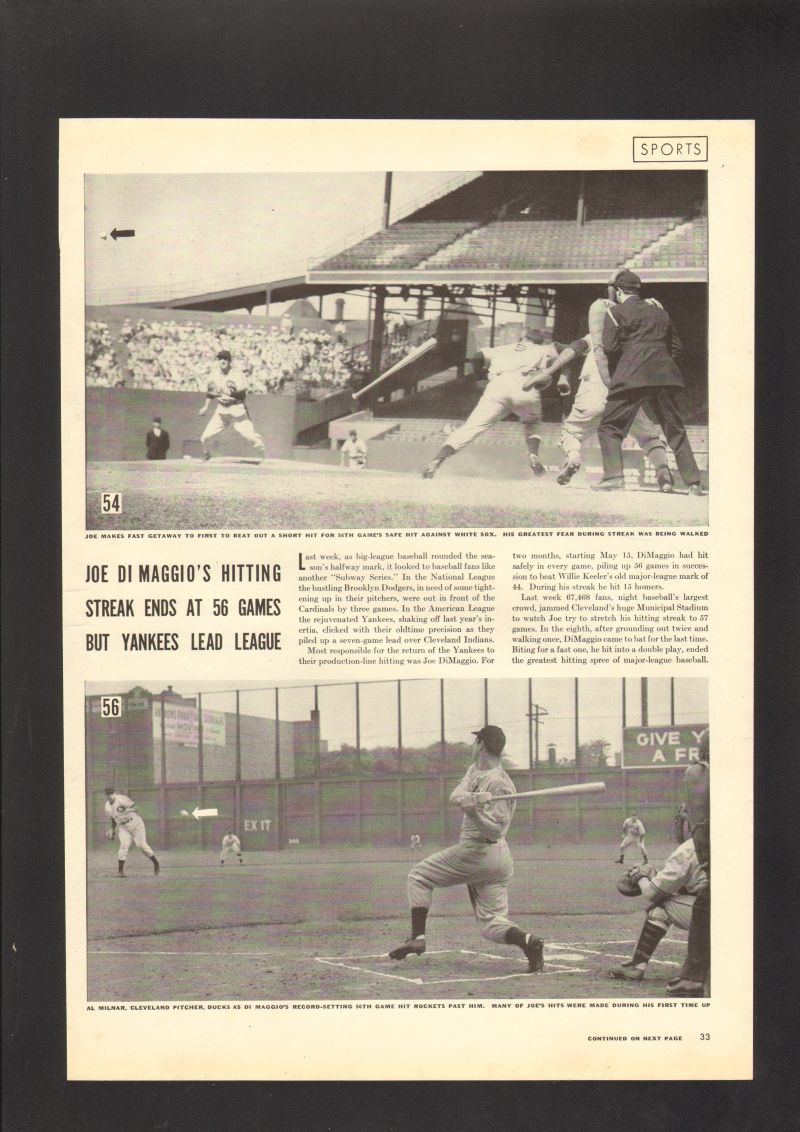 time. Not so with streaks. My favorite streak from recent years was the epic run of wins by
time. Not so with streaks. My favorite streak from recent years was the epic run of wins by 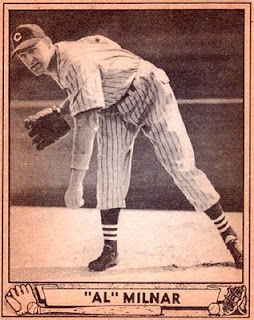 Ken Jennings on the television game show, Jeopardy!. As with DiMaggio’s streak, it developed over time. Pressures mounted as the streak grew. Every day, it was now-or-never.
Ken Jennings on the television game show, Jeopardy!. As with DiMaggio’s streak, it developed over time. Pressures mounted as the streak grew. Every day, it was now-or-never.
Game 56 (bottom photo on left) was the first of three at second-place Cleveland. It was held at League Park, over on the east side. By 1941, the old ball park was showing its age, but DiMaggio was comfortable hitting there. In front of a Wednesday afternoon crowd of 15,000, ‘Joltin’ Joe’ went 3 for 4 with three runs scored in a 10-3 rout of the Indians and pitchers Al Milnar and Joe Krakauskas. Not only were fans following DiMaggio’s streak, but they were also eyeing his advance toward Boston’s Ted Williams for the league’s best batting average. He already was leading the league in home runs and RBI; his average of .375 was creeping into the territory of Williams’ .395. DiMaggio had become a solid candidate for the American League Triple Crown.
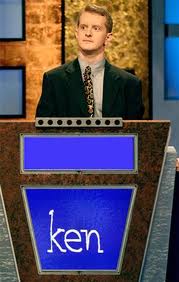 Ken Jennings became the all-time money winner on U.S. television game shows. His Jeopardy! streak in 2004 was the main reason for that. He took advantage of a new rule on the game show that allowed champions to return until they have lost (previously, winners faced a five-game limitation). He ended up with 75 straight wins.
Ken Jennings became the all-time money winner on U.S. television game shows. His Jeopardy! streak in 2004 was the main reason for that. He took advantage of a new rule on the game show that allowed champions to return until they have lost (previously, winners faced a five-game limitation). He ended up with 75 straight wins.
On Thursday evening, Cleveland threw starter ‘Silent Al’ Smith at DiMaggio and the Yankees. Smith was a soft-tossing lefty who surely would not pose the challenge that the Friday game would offer, in Bob Feller. The game was held at huge Municipal Stadium, down on the lakefront, and almost 67,500 fans assembled. (Interestingly, many of the games during the streak had low attendance, even later on.) It had rained earlier in the day, and the field was still thoroughly soaked. When DiMaggio came to the plate in the first inning, the Yankees were up 1-0. There was one out, and Tommy Henrich stood on second base. The crowd's excitement crested. DiMaggio took the first pitch fastball, up and away. The second pitch was a curve that broke in on him. He pulled the ball down the third base line, and it looked like he’d hit a double. The Indians’ third baseman was the highly regarded Ken Keltner. Keltner was playing DiMaggio in shallow left field, right on the line (he knew there would be no ‘cheap’ bunt attempt by DiMaggio). By the time the ball reached Keltner, he was in foul territory. He stabbed the ball and fired a seed to first baseman Oscar Grimes for the out. The play was close,  and the muddy infield certainly had slowed the sprinting DiMaggio.
and the muddy infield certainly had slowed the sprinting DiMaggio.
In the fourth inning, it was still a 1-0 game. Smith (left) threw a 3-2 changeup that DiMaggio fouled off. You know how they say what a pitcher throws once on a 3-2 count, he’ll throw again? Well, Smith didn’t have a power arm, but he could throw four pitches for strikes, on any count. He came next with the curve, similar to the one DiMaggio had hit in the first inning. This time, it broke too far inside. DiMaggio walked. The Cleveland fans booed.
Ken Jennings was obviously brilliant. But the Utah Mormon seemed so gosh-darn likeable, as well. He seemed to win dozens of games without exerting much effort. He appeared comfortable, and enjoyed sharing humor with host Alex Trebek and the audience.
Ken Jennings: “Tool Time for $200, Alex.”
Alex Trebek: “This term for a long-handled gardening tool can also mean an immoral pleasure seeker.”
Jennings, ringing in first as usual: “What is a hoe?” He was incorrect. His grin was worth the $200, however. The correct ‘question’ was “What is a rake?”
The Indians scored in the fourth inning on an inside-the-park home run by left fielder Gee Walker. So by the time of ‘Joltin’ Joe’s’ seventh inning at-bat, the game was tied at 1-1.
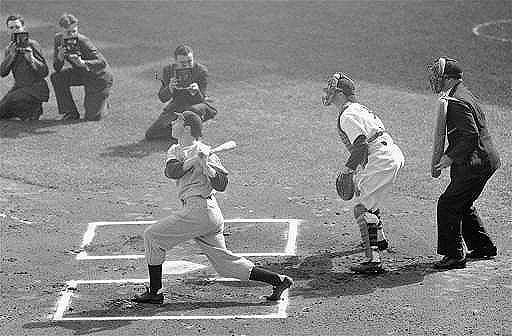 Reportedly, DiMaggio had resolved to go up hacking in the seventh. The crowd began pulling for him.
Reportedly, DiMaggio had resolved to go up hacking in the seventh. The crowd began pulling for him. 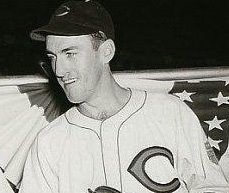 He swung at Smith’s first pitch and in a replay of his first at-bat, he lashed the ball down the third base line. Keltner was there again, and made the same play he’d made earlier.
He swung at Smith’s first pitch and in a replay of his first at-bat, he lashed the ball down the third base line. Keltner was there again, and made the same play he’d made earlier.
By the eighth inning, the Yankees were up, 4-1. With one out and the bases loaded, Jim Bagby, Jr. (right) was summoned by Tribe manager Roger Peckinpaugh to face DiMaggio. Jim Bagby, Sr. was a Tribe pitcher from the past who had a magical season for the World Champion Indians back in 1920, winning 31 games. Bagby, Jr. was an average pitcher with a nice fastball. He struck some as an unfortunate soul who was overly defensive due to a hair lip and a slight speech impediment.
An echoing din from the crowd accompanied Bagby’s confrontation with the Yankee star. He started the pitching sequence with two fastballs, one for a ball and another that DiMaggio fouled off. Bagby showed him the curve, which broke outside. DiMaggio got another fastball that came in low. He offered 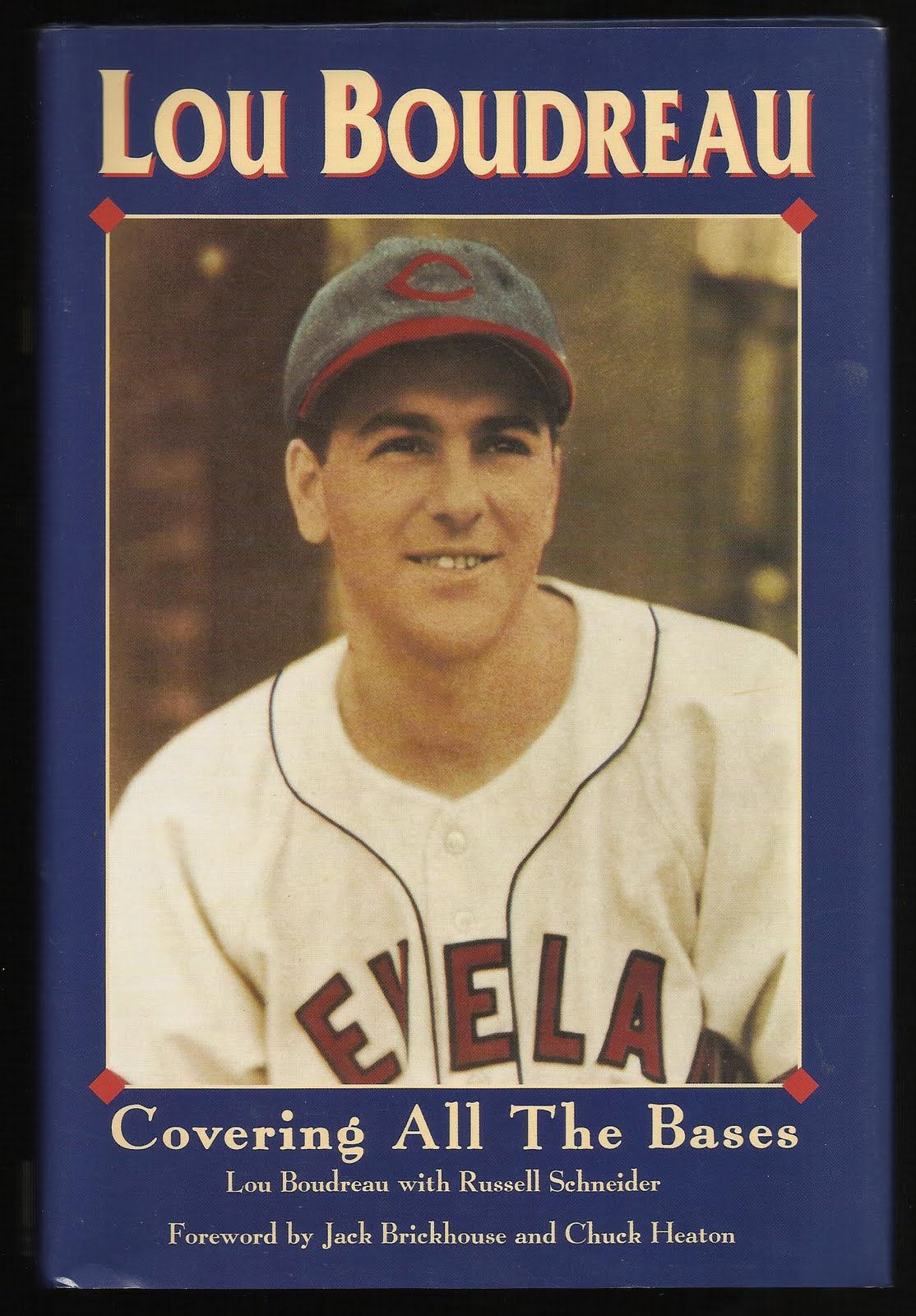 at it, smacking a chopper with tremendous topspin to shortstop. The 24-year-old Lou Boudreau (it was his birthday) was there- and on the last bounce, the ball hopped up on him. With a fine reaction, Boudreau corralled the ball at his chest with both hands. After that, the throw to second baseman Ray Mack and the relay to first completed the double play.
at it, smacking a chopper with tremendous topspin to shortstop. The 24-year-old Lou Boudreau (it was his birthday) was there- and on the last bounce, the ball hopped up on him. With a fine reaction, Boudreau corralled the ball at his chest with both hands. After that, the throw to second baseman Ray Mack and the relay to first completed the double play.
Everyone present figured that would be DiMaggio’s last at-bat. However, in the bottom of the ninth, Yankee starter Lefty Gomez tired. The Indians’ Walker, Mack, and pinch-hitter Larry Rosenthal went single-single-triple to pull within a run of the Yankees, with nobody out. Here is where Rosenthal and the Indians blundered away a chance at tying the game- and a chance for DiMaggio to have another at-bat. As Rosenthal took his lead off third base, first baseman Hal Trosky hit a grounder to first. It should have scored the run, but Rosenthal hesitated and remained at third. One out.
Up came pinch hitter Clarence ‘Soup’ Campbell, who hit one back to pitcher Johnny Murphy. This time, Rosenthal broke for home on contact. He was caught in a rundown and tagged out. Unfortunately, Campbell failed to take second on the play. With two out, Roy ‘Stormy’ Weatherly hit a sharp ground ball down the first base line. But since Campbell was still on first, he was being held by the first baseman. That put him in position to field Weatherly’s smash. No extra innings; no more plate appearances for Joe DiMaggio; the game was over.
As with any long streak, the reason Ken Jennings lost is remembered as much or more than the details of his dominance. In that final game, he found both Double Jeopardy! Daily Doubles, but was incorrect on both of them. He lost a combined $10,200, and for only the tenth time in 75 games, he would not win in a runaway. In other words, his challenger had a shot to beat him in Final Jeopardy!. Jennings and fellow contestant Nancy Zerg were faced with the ‘answer’, from the Business and Industry category: “Most of this firm’s 70,000 seasonal white-collar employees work only four months a year.” The correct ‘question’ was, “What is H&R Block?” Jennings’ response was, “What is Fed Ex?” Zerg’s response was correct.
For his part, Joe DiMaggio remained as stoic as ever. His team had just won a game with serious pennant implications, but his teammates were quiet in the clubhouse. How would Joe react? He broke the silence with his light-hearted declaration that it was over. He obliged photographers, who’d requested he hold up his hands showing ‘zeroes’ to signify that he hadn’t gotten a hit that day (photo at top). He’d later share his feeling that he was like a boxer who’d been knocked out. It took him a couple days to feel normal again. Of course, DiMaggio would start another hitting streak the next day, against Feller.
Joe DiMaggio, already an American icon, had added a crowning achievement to his Hall of Fame career in 1941. Ted Williams would famously hit over .400, while DiMaggio won the A.L. MVP Award in leading the Yankees to another World Series victory. But his popularity was owed not only to his ability, but to his public persona as a pleasant, humble, hard-working hero.
Ken Jennings became a hot commodity in the entertainment world. He would appear in many media outlets, from Live with Regis and Kelly, Nightline, a Barbara Walters special, Sesame Street, TV Guide, Biography, and countless other news and game shows. He’s written several books, and penned a magazine column for a few years.
H&R Block offered free financial and tax services for life.
He reportedly was asked by Democrats Chuck Schumer and Harry Reid to run for the U.S. Senate in Utah. Jennings’ comment on that: “That was when I realized the Democratic Party was f@#$ed in ’04.”
From an appearance on David Letterman, some of the top ten ways to aggravate Trebek:
8. “Buzz in without using your hands”
5. “Tell him he’s no Wink Martindale”
2. “Your only response: ‘Who gives a rat’s ass?’”
1. “Insist on buying a vowel”
Thank you for reading. Sources included Wikipedia; Tribe Memories, the First Century , Schneider; the official Joe DiMaggio website; The Cleveland Indians Encyclopedia, Schneider; 56: Joe DiMaggio and the Last Magic Number in Sports, Kennedy; theweek.com; baseball-reference.com.
A nice photo of DiMaggio and Keltner, probably around twenty years later:
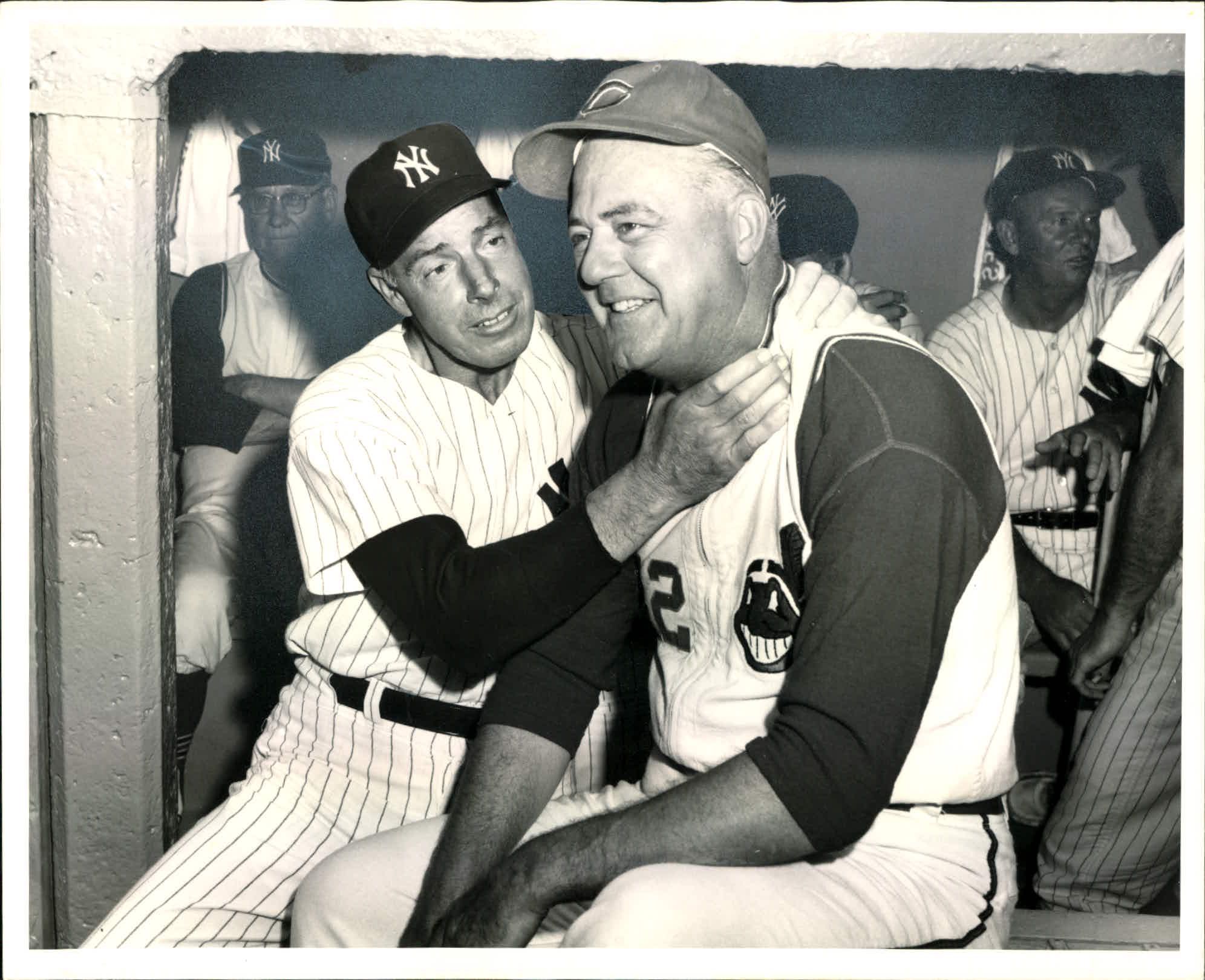
- NBA Announces 2013-2014 Schedule
- Browns Ink Sharknado
- Sharknado A No-Show For Rookie Camp
- Trent Richardson Out Until Training Camp
- Browns Sign Brandon Jackson
- Carrasco Suspended Eight Games
- Browns Add to Wide Receiver Depth with David Nelson
- Browns Need to Learn from Past Draft Mistakes
- Browns Release Chris Gocong and Usama Young
- Browns Missing on Grimes Disappointing, But Not The End
The TCF Forums
- Chris Grant's first 3 drafts
Kingpin74 (Tuesday, January 21 2014 10:13 AM) - The 2014 Offseason Thread
googleeph2 (Tuesday, January 21 2014 9:36 AM) - 2015 Recruiting
furls (Tuesday, January 21 2014 6:57 AM) - Mike Brown
YahooFanChicago (Monday, January 20 2014 11:15 PM) - Movies coming out
HoodooMan (Monday, January 20 2014 9:34 PM) - 2014 Hoops Hockey Hijinx
jpd1224 (Monday, January 20 2014 4:44 PM) - 2014 Recruiting
jclvd_23 (Monday, January 20 2014 2:26 PM) - Wish List - #4 Pick
Hikohadon (Monday, January 20 2014 1:26 PM) - Official- Browns Coach Search/Rumors
OldDawg (Sunday, January 19 2014 6:48 PM) - #1 overall pick Anthony Bennett
TouchEmAllTime (Sunday, January 19 2014 1:28 PM)


